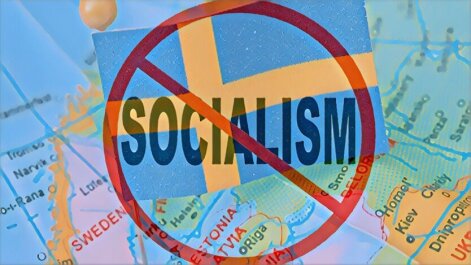At the end of July 2023 Swedish historian/economist Johan Norberg has published another excellent book, The Mirage of Swedish Socialism.
An Economic History of the Welfare State” The Mirage of Swedish Socialism. The Economic History of a Welfare State . The myth of Swedish socialism is deeply embedded in the creation of the inhabitants of the post-Soviet space.
As part of the campaign to detoxify consciousness from historical myths, propaganda cliches and political lies, I highly recommend that you familiarize yourself with the entire work. It is small, only 97 pages.
I will allow myself a brief summary of the main theses, facts and conclusions of the Swedish scientist and world-famous lawyer for freedom.
Every time a proposal to name a successful socialist country arises in a dispute, Sweden invariably sounds. Moreover, the lies about Swedish socialism are repeated by both the socialists of America, the imperialists of Russia, and the supporters of the Big State in the post-Soviet space.
The image created on the basis of the development of this country for only ~20 years (1970-80s) has firmly become a propaganda stamp. During this period, Sweden was indeed moving towards socialism (high taxes, government spending, government ownership of businesses and all-encompassing regulation). Statistics confidently show that it was during this period that it lagged behind developed countries.
The culture of freebies (receiving all kinds of goodies from the state) has intensified, the spirit of entrepreneurship has weakened, and the outflow of human capital has accelerated.
The most successful Swedish companies (IKEA, Tetra Pak) left the country. It ended in a big economic disaster: a high budget deficit and unbalanced finances, exorbitant inflation, devaluation of the national currency and accumulation of debts.
Twenty years of fiscal irresponsibility, Big State and ignorance of the laws of the economy is a long enough period to destroy or seriously undermine the health of even the most prosperous country.
It should be noted that around the same time, New Zealand was on the path of expanding socialist practices. It went bankrupt about five years before Sweden. She, too, learned her lessons and over the next 20 to 25 years also successfully implemented the liberal agenda.
In the early 1990s, we were all preoccupied with the collapse of the Soviet evil empire. We were not up to the Swedes. But the economic crisis was brewing there. It was there that it was necessary to look for answers to questions about which model, the method of transformation to choose.
Imagine that in order to achieve macroeconomic stabilization, the Central Bank of Sweden was forced, albeit for a short period of time, to raise the interest rate to 500% per annum. As a result of bankruptcies of enterprises, unemployment increased sharply.
In the spirit of national unity and responsibility, the main political parties in Sweden have decided to return to the good old capitalist model. True, not completely, not everywhere, but still the level of economic freedom was very high.
There was a deregulation of the economy, tax cuts (the elimination of the tax on wealth, gifts and inheritance), reduction in government spending and the adoption of a tough plan to get out of their debt trap, as well as privatization, including the pension system. But first things first.
Sweden has been a world leader in the freedom and capitalism movement for 100 years
The Swedes themselves categorically oppose the image of Sweden as a socialist country. In its long history, the country has been a free market country for the lion's share of the time.
Therefore, she was successful. In 1840, this country carried out a radical liberalization and ensured rapid economic growth. In the early 1950s, it was the fourth richest country in the world. At the same time, she was one of the most free. Government spending was less than 20% of GDP. Other Western European countries had larger states. Taxes in Sweden in the middle of the 20th century were even lower than in the USA.
In the period 1840 -1870. Sweden led a peaceful liberal revolution. Legal guarantees of private property rights, including the full right to own, divide, sell, buy land. Regulatory barriers in the timber and metallurgical industries were abolished. Guilds were liquidated.
Every Swede received the right to freely engage in business. In 1848 The law on the company with limited liability was passed. The old banking system was destroyed, a new one was created, with a free regime for setting interest rates. In 1865 an international free trade agreement was signed with France and Britain.
Freedom of speech and religion, the rights of women to own property, to receive education - all this Sweden received in the second half of the 19th century. In 1860 Restrictions on the internal movement of people have been lifted.
At the same time, a liberal migration regime was adopted. In the beginning, about a million Swedes left for America, but then many returned with ideas, money and work experience.
Deep liberal reforms gave their result. In the period 1870 - 1970. Sweden increased GDP per capita by 8.5 times. The best result for this time has only one country in the world - Japan. In 1820 Sweden's GDP per capita was more than half that of Britain.
By 1950, Sweden and Britain were on the same level, and in 1970 Sweden outperformed Britain by 20%. In 1870, Sweden was an outsider in Europe. By 1970, only the United States, Switzerland, and a few Arab oil countries were ahead of it.
In the period 1870-1910 the Swedish economy grew almost as fast as the American one: 1.7% average annual growth rate versus 1.9%. Real wages grew even faster, by 2.8% per year. For comparison, in the USA, Britain, France and Germany it was 1.1%. Natural resources attracted capital from all over the world. At the same time, until 1930, government spending did not exceed 10% of GDP.
Of course, it could not do without tough political and ideological disputes. The scent of socialism could not but penetrate into Sweden, but its healthy liberal forces confidently held the blow. In 1950 Sweden was one of the three freest countries in the Western world (after the USA and Switzerland).
Government spending was less than 20% of GDP, much lower than in Britain, France and West Germany. The marginal income tax rate in Sweden was 20 percentage points lower than in the United States. In other words, "Sweden was the richest, healthiest and most successful country in human history."
This was BEFORE liberal, free-market Sweden began to evolve into a welfare state (welfare state) or, to call a spade a spade, a general interventionist state.
Failed socialist experiment
After 100 years of economic, social success, Sweden took a perfectly functioning economy for granted. The Swedish elites have relaxed because they have lost sight of the critical axiom "Freedom is not free."
Freedom must be paid for, first of all, in the form of the production of knowledge and the formation of the value of people (information support). Calls to collect and distribute sounded louder and louder. There were generous government programs. The freebie sucked the country into a funnel of crisis imbalances.
From 1965 to 1985 government spending more than doubled, from 25.4% of GDP to 58.5% of GDP. The main new items of expenditure are health care, child benefits, pensions and housing support. The marginal tax rate on workers rose from less than 40% in 1960 to to over 60% in 1980.
For managers, the rate was over 70%. Payroll taxes rose from 12.5% in 1970 to up to 36.7% in 1979 In the 1980s, the corporate income tax rate approached 60%. In addition to the fiscal burden, the regulatory burden has grown sharply. In 1970 Sweden has introduced a price regulation system. Labor market regulation has been tightened.
In the oil crisis of the 1970s, the Swedes, in the heat of the socialist experiment, increased their labor costs by 40% in 1975-76. The result was predictable: a sharp rise in production costs, which hit the guts of Swedish industry and exports. In 1974 -1977. steel production fell by 30%, shipbuilding by half, and the light and mining sectors of industry were in a coma.
The Swedish authorities bailed out businesses with grants and subsidies in order to keep employment. This went on from 1976 to 1982. However, the poison of the socialist experiment was not drunk to the dregs by the political elites. An "emergency industrial policy" appeared on the agenda.
It involved granting immunity to business bankrupts at the expense of taxpayers. In 1977 shipbuilding was practically nationalized. The same thing happened to the steel industry.
That's what happened to the Swedish krona. It was pegged to the German mark, and then to the European ecu. In 1976 it was devalued by 3% in 1977. - by 6% and then by 10%. In 1981 came another devaluation - by 10%.
In 1982 after the Social Democrats came to power, another devaluation of 16% followed. These decisions were largely the result of pressure from unions to raise wages. Devaluation temporarily helped individual exporters, but could not solve the structural problems of the economy. In 1970-1990. Sweden's share of exports to OECD countries fell by 30%.
By the end of the 1980s, problems in the labor market sharply worsened. Despite the fact that the population of the country increased by 1.5 million from 1950 to 1990. not a single "clean" job was created in the private sector (balance of created and liquidated).
However, there has been a significant increase in employment in the public sector. From 1970 to 1987 the government has never been able to balance the state budget. It was chronically in short supply. As a result, the public debt rose from 18% of GDP in 1970 to to over 70% in 1985. It was during the period of all-encompassing state interventionism that Sweden lagged behind the developed countries in various parameters of industrialization.
Investment levels fell from one percentage point above OECD countries to several percentage points below. Labor productivity in the period 1960-1970. increased by 4.6% per year. In 1970-1990, when the state decided to help the economy, this figure dropped to 2% per year.
During this period, labor productivity grew by 3.2% per year in OECD countries. In 1970 GDP per capita in Sweden was 25% higher than in Western Europe. In 1980 it was only 14% higher, and in the early 1990s Sweden was already behind.
Sweden's economic policy has successfully driven business leaders, sports and music stars out of the country. In 1973 the head of IKEA I. Kamprad moved to the Netherlands. In 1981 Tetra Pak has moved to Switzerland. Fredrik Lundberg, one of the richest Swedes, left the country in 1985.
Tennis player B. Borg, the world leader in alpine skiing I. Stenmark, the great film director I. Bergman - they all left Sweden. A. Lingren, the world famous children's writer, complained that during one of the tax periods she was forced to pay 102% of the income received. Equalization through exorbitant income tax rates pushed the country into a crisis.
In the early 1990s, it was impossible not to recognize the failure of the Swedish socialist experiment. Sweden was ready to be transformed into a capitalist welfare state model. To get out of the crisis, the country turned to those tools and institutions that ensured its prosperity in the past.
Reducing government spending, reducing social benefits, including unemployment benefits, selling state-owned enterprises, liquidating state funds - the classic liberal agenda.
For the first time, private radio and TV broadcasting was allowed. Telecom, energy, domestic aviation and the railway went through deep deregulation. The remnants of state price controls have been eliminated, with the exception of the infamous control over rental rates.
In 1992 A revolutionary for that time voucher system was launched in secondary education. Private alternatives to public kindergartens and nursing homes have emerged. In 1994 privatization of the pension system began.
Yes, public spending in Sweden remains at a very high level. The harm from this is compensated and neutralized by the very high quality of public administration institutions, macroeconomic policy, the legal system and a very high-quality business climate.
Swedish lessons for Ukraine
The rich economic history of Sweden contains many valuable lessons for Ukraine. Let's formulate the main ones:
1) Sweden has become one of the richest and most successful countries in the world due to a long-term (~100 years) commitment to the theory and practice of freedom, to the legal institutions of capitalism. Economic science and history do not know of a single country example when wealth and prosperity would be provided by socialist institutions and methods.
2) Sweden chose the model of entrepreneurial growth and a small state (up to 20% of GDP) precisely because it was poor, disassembled and in crisis. The only way known to science and history - Sweden confirms this - to improve the quality of life, social standards in the long term - to stake on capitalism and freedom.
3) It is critically important to constantly invest in the philosophy, theory, practice of freedom and capitalism, so as not to become a victim of the priests of collectivism, Bolshevism and other models of enslaving a person of work by VIP managers and consumers of someone else's.
4) To anyone who proves to you the advantages of socialism by referring to Sweden, show this article or the book The Mirage of Swedish Socialism. If a person continues to promote the ideas of socialism after that and shamelessly uses the cliché "Swedish socialism", you can be sure that he is deprived of the ability to think. He is a zombie or a hired worker of the socialist evil empire.
5) Long-term success for a poor, disassembled, torn by internal strife country is possible only on the basis of a broad ideological consensus of economic, political, cultural and intellectual elites. The foundation of such unity is political, personal, civil and economic freedom as a whole.
6) The larger the size of the State, the wider the powers/discretion of the Official, the less private property in the country, the deeper the ideas of equalization, dependency and idolization of the State are rooted in society, the lower the chances of 97% of the country's population for a prosperous, happy life.
7) It is critical to neutralize your phobias, fears, gaps in knowledge, defects of logic (security, poverty, unemployment, illness, uselessness) not by turning off the brain (alcohol, drugs, social escapism, blind faith in memes, punchlines, headlines, tweets, pictures, opinions of ideologues/propagandists on TV or Youtube).
The only way known to mankind to obtain knowledge, objective information is to read, read and read again.
Books, reports, scientific articles, analytical notes, historical reviews, interviews with authoritative scientists/experts - this is the way to enlightenment, to detoxify one's consciousness from lies/stamps like "Swedish socialism" or "socialism made Sweden rich".

























